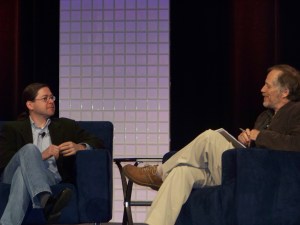
Schwartz says his top job is being a communicator as CEO. Getting a message across to the troops, who ask him questions like “Why did we spend $1 billion on a company (MySQL) that gives away its products for free?” How does he keep his own voice and PR out of it, O’Reilly asked. Schwartz said it did terrify him when his general counsel started blogging.
[aditude-amp id="flyingcarpet" targeting='{"env":"staging","page_type":"article","post_id":91482,"post_type":"story","post_chan":"none","tags":null,"ai":false,"category":"none","all_categories":"business,","session":"D"}']Schwartz said Sun spent so much money on MySQL (a low-cost open-source database product that can be hooked up with Sun’s servers to run modern Web sites) because “they’re making good money, they’re not a charity. That has real tangible value. They were in the midst of filing an S-1 to go public.” He saw synergy in the deal. And the 70,000 people who download MySQL can put it on Sun computers, making those Sun computers more useful, Schwartz said.
He noted that Sun distributes 50 million Java runtimes a month and those generate “data exhaust,” meaning a need to crunch a lot of data and therefore demand for Sun machines.
AI Weekly
The must-read newsletter for AI and Big Data industry written by Khari Johnson, Kyle Wiggers, and Seth Colaner.
Included with VentureBeat Insider and VentureBeat VIP memberships.
O’Reilly asked about “utility” computing, which lets you buy servers in a pay-as-you go model. Schwartz referred to Amazon’s web services, which offers this. How far along is it? “Let’s get to transparent pricing,” Schwartz said. We’re a long way from that.
Social networking and high performance computing markets are growing like weeds now within the enterprise. That’s because Moore’s Law is making CPUs so inexpensive, which in turn allows small social networks to start small and grow big. He called out Aggregate Knowledge, which has an Amazon-like recommendation technology that shows consumers on a site “people who bought this also bought that.” Schwartz says Aggregate Knowledge needs larger and larger scale SMP machines because their databases are growing huge.
“All horizontal scale ultimately scales vertically,” he said. “That to me defines what is going on in the computing marketplace.”
He said that people have the impression that Google runs on simple one-core Intel-based computers whereas the average “node” on servers in the data centers are now hefty four-core machines that run multiple threads. That’s much more like the kind of machine that Sun makes rather than generic Intel-based server vendors, he said.
“There is no doubt in my mind” that the market will come back in Sun’s direction, Schwartz said. That is, powerful computers with lots of cores running lots of threads with efficient power consumption.
[aditude-amp id="medium1" targeting='{"env":"staging","page_type":"article","post_id":91482,"post_type":"story","post_chan":"none","tags":null,"ai":false,"category":"none","all_categories":"business,","session":"D"}']
“I was with the largest IT spenders a while ago and asked them if they were responsible for their power bills,” he said. “Only half raised their hands. But power is the No. 2 cost in a data center next to people.”
He said Sun has “greened its infrastructure” by doing designing chips more processing in parallel rather than in high performance, high power consumption. Niagara, the chip platform that implemented this strategy with many cores on one chip, went from zero to $1 billion run rate in 18 months.
O’Reilly asked about the Black Box, or the decentralized data centers Sun is now deploying with its customers. With that project, Sun designed a data center module with servers as well as its own power sources inside a mobile shipping container (like the kind they take off cargo ships).
“I would agree with you,” he said. “The network is the computer. But data is the currency.”
[aditude-amp id="medium2" targeting='{"env":"staging","page_type":"article","post_id":91482,"post_type":"story","post_chan":"none","tags":null,"ai":false,"category":"none","all_categories":"business,","session":"D"}']
Sadly, O’Reilly didn’t ask him why Sun bought Montalvo for cheap, a fact that Sun confirmed yesterday.
VentureBeat's mission is to be a digital town square for technical decision-makers to gain knowledge about transformative enterprise technology and transact. Learn More
